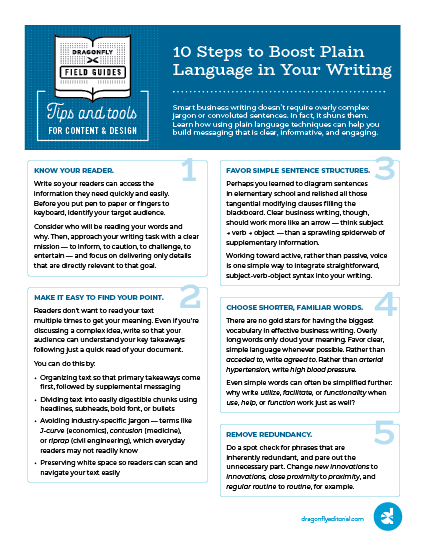Smart business writing doesn’t require overly complex jargon or convoluted sentences. In fact, it shuns them. Learn how using plain language techniques can help you build messaging that is clear, informative, and engaging.
1. Know your reader
Write so your readers can access the information they need quickly and easily. Before you put pen to paper or fingers to keyboard, identify your target audience.
Consider who will be reading your words and why. Then, approach your writing task with a clear mission — to inform, to caution, to challenge, to entertain — and focus on delivering only details that are directly relevant to that goal.
2. Make it easy to find your point
Readers don’t want to read your text multiple times to get your meaning. Even if you’re discussing a complex idea, write so that your audience can understand your key takeaways following just a quick read of your document.
You can do this by:
- Organizing text so that primary takeaways come first, followed by supplemental messaging
- Dividing text into easily digestible chunks using headlines, subheads, bold font, or bullets
- Avoiding industry-specific jargon — terms like J-curve (economics), contusion (medicine), riprap (civil engineering), which everyday readers may not readily know
- Preserving white space so readers can scan and navigate your text easily
3. Favor simple sentence structures
Perhaps you learned to diagram sentences in elementary school and relished all those tangential modifying clauses filling the blackboard. Clear business writing, though, should work more like an arrow — think subject → verb → object — than a sprawling spiderweb of supplementary information.
Working toward active, rather than passive, voice is one simple way to integrate straightforward, subject-verb-object syntax into your writing.
4. Choose shorter, familiar words
There are no gold stars for having the biggest vocabulary in effective business writing. Overly long words only cloud your meaning. Favor clear, simple language whenever possible. Rather than acceded to, write agreed to. Rather than arterial hypertension, write high blood pressure.
Even simple words can often be simplified further: why write utilize, facilitate, or functionality when use, help, or function work just as well?
5. Remove redundancy
Do a spot check for phrases that are inherently redundant, and pare out the unnecessary part. Change new innovations to innovations, close proximity to proximity, and regular routine to routine, for example.
6. Employ one strong word
Resist the temptation to fluff up your writing with wordy phrases, when a single, concise term will do. After all, you’re a professional, not a student stretching to make a 1,000-word essay minimum. Rather than in order to, simply write to.
Other examples include:
- In conjunction with → with
- In the event that → if
- Until such time as → until
- In a timely manner → promptly
- It should be noted that → note
- On a monthly basis → monthly
7. Be precise
Whenever possible, be specific and concrete. Instead of suggesting readers use “a tool” for repairs, tell them they’ll need a screwdriver, for instance. Similarly, in memos to staff, rather than noting your meeting “starts after lunch,” use the less ambiguous wording “begins at 1 p.m.”
8. Use acronyms sparingly
Too many acronyms can create acronym soup in your document — and glazed-over eyes on your reader’s part. Replace repetitive acronyms with other meaningful words to describe organizational bodies instead, such as “the council” or “the agency.”
9. Prioritize readability
Business writing is not novel writing — and their best practices widely differ. While Faulkner may be known for page-long paragraphs, your corporate communications shouldn’t be. Create “readable” text by:
- Addressing just one key idea per paragraph
- Breaking up any paragraph with more than seven lines of visual text
- Striving for an average sentence length of just 14 words
To dive even deeper, use embedded tools in either Word or Google Docs to learn your document’s readability score.
Hint: you want your text to fall between a fifth- and ninth-grade level on the Flesch-Kincaid readability scale or have reading ease equal to or greater than 60 on the Flesch Reading Ease scale.
10. Explore plain language writing resources
At its core, plain language is writing that lets readers get what they need, find what they need, understand what they find, and use that information. For more tips on plain writing best practices, check out available resources such as:


